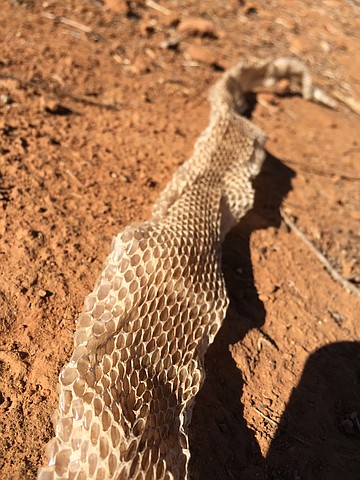 Facebook
Facebook
 X
X
 Instagram
Instagram
 TikTok
TikTok
 Youtube
Youtube

Rancho San Diego ambrosia (aka Ambrosia pumila) came out from the weeds Saturday (November 5) as a dozen volunteers and agency staffers scraped and swiped weeds — and discovered the skin left behind by a molting rattlesnake — from the surface of a plot at San Diego National Wildlife Rescue.
"The weeds provide too many nutrients in a nitrogen-rich environment for the ambrosia," U.S. Fish and Wildlife Service biologist John Martin explained to volunteers.
The tiny perennial herb, on the endangered-species list, now grows in only a few places in Southern California. The U.S. Fish & Wildlife Service has planted plots of it in the refuge area in Rancho San Diego, about a mile due south of Cuyamaca College.
"It's doing well here, but the nonnative plants present a challenge," Martin said.
With small, widely spaced rakes, buckets, and gloves, volunteers cleared the dry, dead grasses from about 700 square feet of land, exposing the gray-green, furry little plants to more air, sun, and, hopefully, rain.
One of the great discoveries of the day was that the patch being cleared had spread. Martin pointed past the project perimeter.

"The plant spreads by rhizomes underground," he said. "If you pulled one of these up — which is illegal under the endangered-species act — you would find it is connected by long rhizomes to plants way over there." By that measure alone, the cultivated patch is a success.
Ambrosia made the endangered species list in 2010 after a series of lawsuits and attempts to list the plant. There are 19 known populations, 14 of which are in San Diego County, 2 in Riverside, and the rest in Mexico. The plant grows well in grasslands, particularly near vernal pools, according to the Center for Biological Diversity.
As gloved volunteers moved the grass, they also found pieces of the skin snakes lost while they were molting, including an intact tube of skin about two feet long that went from the back of its head to the closed tail and has the faint pattern of diamonds. "By the coloring, I believe it's from a red diamondback rattlesnake," Martin said.


Rancho San Diego ambrosia (aka Ambrosia pumila) came out from the weeds Saturday (November 5) as a dozen volunteers and agency staffers scraped and swiped weeds — and discovered the skin left behind by a molting rattlesnake — from the surface of a plot at San Diego National Wildlife Rescue.
"The weeds provide too many nutrients in a nitrogen-rich environment for the ambrosia," U.S. Fish and Wildlife Service biologist John Martin explained to volunteers.
The tiny perennial herb, on the endangered-species list, now grows in only a few places in Southern California. The U.S. Fish & Wildlife Service has planted plots of it in the refuge area in Rancho San Diego, about a mile due south of Cuyamaca College.
"It's doing well here, but the nonnative plants present a challenge," Martin said.
With small, widely spaced rakes, buckets, and gloves, volunteers cleared the dry, dead grasses from about 700 square feet of land, exposing the gray-green, furry little plants to more air, sun, and, hopefully, rain.
One of the great discoveries of the day was that the patch being cleared had spread. Martin pointed past the project perimeter.

"The plant spreads by rhizomes underground," he said. "If you pulled one of these up — which is illegal under the endangered-species act — you would find it is connected by long rhizomes to plants way over there." By that measure alone, the cultivated patch is a success.
Ambrosia made the endangered species list in 2010 after a series of lawsuits and attempts to list the plant. There are 19 known populations, 14 of which are in San Diego County, 2 in Riverside, and the rest in Mexico. The plant grows well in grasslands, particularly near vernal pools, according to the Center for Biological Diversity.
As gloved volunteers moved the grass, they also found pieces of the skin snakes lost while they were molting, including an intact tube of skin about two feet long that went from the back of its head to the closed tail and has the faint pattern of diamonds. "By the coloring, I believe it's from a red diamondback rattlesnake," Martin said.
Comments